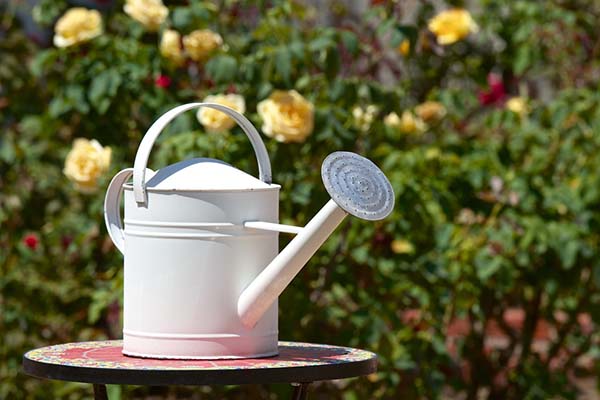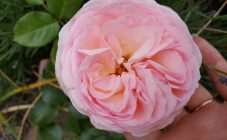Content:
Rose Double Delight is a popular variety of the hybrid tea group of plants. The main distinguishing characteristic of the culture is a varied color palette, even within the same bush. The flowers of these roses are painted in 2 tones: the creamy core is surrounded by crimson petals. In the process of opening the bud, the crimson color becomes brighter and more saturated.
General characteristics of culture
The class of hybrid tea roses includes more than 10,000 varieties. They are mainly planted in flower beds, used to decorate parks, gardens, squares, as well as for cutting, since most varieties of this class stand in the water for a long time. All hybrid tea roses are distinguished by long flowering.
This variety was introduced to Europe from the Californian island of Vasco in 1982 by Joseph L. Luna. The rose received the name "Double Pleasure", which may be due to the specific color of the flower or the combination of visual appeal and wonderful aroma. For all the time, the variety has been marked by many awards at various exhibitions and has won wide popularity among flora lovers.
The flower gives off a strong fruity aroma. Coloring of buds: inside the petals are beige, outside are crimson. The more sunlight the rose absorbs, the richer the colors become. If the crop is grown in a greenhouse, the buds remain beige, while the raspberry hue is very weak.
Description of the Double Delight variety
The blossoming bud reaches 12-15 cm in diameter. The flowering period of the Double Delight rose is divided into 2 stages: the first wave falls at the beginning of summer, the second - at the end of August. On each shoot, there is one flower and rather large leaves of a dense green color with a shiny surface. The height of the bush is about 120 cm.
The variety has frost resistance, so it can be grown in most regions of Russia. In this case, the flower must be provided with a winter shelter.
Often, the Double Delight hybrid tea rose is confused with another popular variety of Nostalgia, which is characterized by:
- double color, including cream on the inside and cherry on the edges of the petals;
- strong fruity aroma;
- continuous flowering throughout the summer season.
Unlike Nostalgia, the Double Pleasure rose is less resistant to precipitation. In addition, the Nostalgie variety is not susceptible to diseases such as powdery mildew, which often affects the hybrid tea variety.
Growing and care
The landing site should be well lit with diffused light. In the shade, flowering does not stop, but becomes less intense, the buds fade, the crimson color disappears.
The culture does not tolerate hot weather. At an air temperature of +30 degrees and above, the flowers dry out, curl. At this time, it is necessary to often water the plant with plenty of water. Placing a rose in an open area in such weather will entail overheating of the plant.
The root of the flower should be protected from the wind. To do this, the culture can be planted next to the fence or wall of the house. Bushes should be located at a distance of a meter from each other. When placed close together, roses will be deprived of enough light and space for normal root development.Thickened plantings impede airing of the bushes, which can lead to the appearance of fungus.
If the plant is planted in a container, a drainage layer is placed on the bottom of the container so that the roots do not suffer from excess moisture.
Soil and planting technology
The planting hole must be dug to a depth of at least 50 cm, since the root system of this variety is very developed. Loosen heavy soil by adding peat or sand to it. To fill the soil with nutrients, you need to add mineral and organic fertilizers to it.
The planting of the culture is carried out in the second decade of May, when warm weather sets in. A rose with an open root system should stand in water for a while.
After rooting the seedling, the rose is watered, and the soil is carefully compacted.
Rose care
As for watering, this procedure is a guarantee of successful flower cultivation. The soil should not dry out or be too wet. One watering of a young plant takes up to 5 liters of water, for an adult bush - at least 10-15 liters. In this case, the water should be warm, settled.
When watering, they also feed the flower. At the first time after planting, the crop needs nitrogen-containing fertilizers. Such feeding promotes intensive growth and formation of shoots. When buds appear, the rose is fertilized with mineral mixtures. The event is held every 2-3 weeks. In one season, about 5-6 dressings come out.
Fertilizers are applied during the period of active growth of the culture until the end of the flowering of the rose.
Pruning and sheltering for the winter
Shoots are cut off before wintering, leaving 40 cm from the stem. The planting site is covered with a layer of peat up to 30 cm in height. Next, a support is installed above the plant and covered with a film or spruce branches. Until frost is established, the lower part of the frame is not completely closed so that fresh air can penetrate there and moisture does not accumulate.
To form a neat, moderately branching bush, it is necessary to correctly trim the flower. In order for the culture to form basal shoots and the bush becomes lush, a young plant must be pinched after the first 4 leaves appear on it.
Weak stems without buds should also be trimmed.
After the end of flowering, remove the faded stems.
During flowering, you need to remove those flowers that have wilted. Also, during the period of prolonged rains, unblown buds should be cut off, otherwise the plant may get sick with gray rot.
Diseases and pests
This variety is not highly resistant to disease. To prevent their development, it is necessary to carry out preventive treatment of the shrub.
Rose is susceptible to diseases such as:
- powdery mildew - appears in cold damp weather; to prevent disease, the plant is treated with fungicidal preparations;
- black spot - in this case, use drugs Fundazol, Floxin;
- gray rot - treatment with fungicides is required;
- rust - it is impossible to get rid of it; for prevention, the rose is treated with calcium nitrate.
This variety is threatened by such pests as:
- aphid - to fight the parasite, the flower is sprayed with Karbofos or Confidor;
- leaf roll - spraying with Chlorophos will help eliminate the problem;
- sawfly - the soil must be loosened, and the bush must be treated with Aktellik.
Advantages and disadvantages of the variety
The culture has the following positive characteristics:
- great appearance;
- long flowering;
- frost resistance;
- strong, pleasant smell;
- persistence in bouquets and in a vase.
Among the disadvantages of the Double Delight variety should be highlighted:
- rather weak resistance to diseases and pests;
- the impossibility of growing as an indoor flower;
- inability to endure too hot weather;
- intolerance to excess moisture and poor resistance to precipitation.
Rose Double Delight is perfect for planting in summer cottages and garden plots. In matters of cultivation and care, the culture is not too demanding, the main thing is to plant it in a bright area, do not overflow, fertilize it on time and cut it correctly.
















